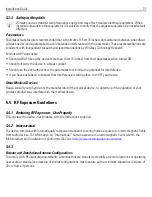
Installation Guide
25
7.
Expand the
Configuration
menu item and select
Basic
.
8.
Set the following
Basic Configuration Settings
for this Access Point:
•
AP Name
- Provide an AP Name used as this Access Point’s WiNG Express network identifier. If
setting this Access Point as a Virtual Controller, each Access Point managed by this Virtual Controller
lists this Access Point’s AP Name as its own. The AP Name is a required parameter.
•
Country Code -
If the Country Code was not set when the Access Point was initially powered on, set
the country now to ensure the Access Point’s legal operation. The Access Point’s wireless capabilities
are disabled until the required country code is set.
•
Virtual Controller
-Select this option to define this Access Point as a Virtual Controller capable of
managing and provisioning up to 24 Access Points of the same model. If selecting this Access Point
as a Virtual Controller, those Access Points managed by this Virtual Controller will list this Access
Point’s AP Name as its own. Only one Virtual Controller can be designated.
•
Timezone
- Use the drop-down menu to specify the geographic timezone where the Access Point is
deployed. Different geographic time zones have daylight savings clock adjustments, so specifying the
timezone correctly is important to account for geographic time changes.
•
Date & Time
- Set the date, hour and minute for the Access Point’s current system time. Specify
whether the current time is in the
AM
or
PM
.
•
NTP Server
- Optionally provide the IP address of a NTP server resource.
Network Time Protocol
(NTP)
manages time and/or network clock synchronization within the WiNG Express network. NTP is a
client/server implementation. Access Points (NTP clients) periodically synchronize their clock with a
master clock (an NTP server). For example, an Access Point resets its clock to 07:04:59 upon reading
a time of 07:04:59 from its designated NTP server.
9.
Select
Apply
to implement the updates.






























